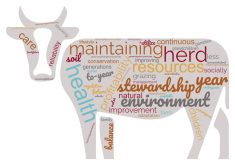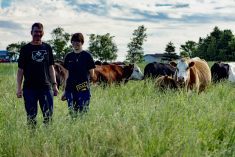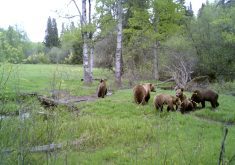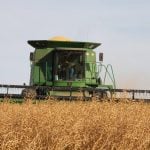When World Wildlife Fund plans to act on its sustainability goals for the Northern Great Plains, partnering with stakeholders in the beef value chain pushes these initiatives further.
World Wildlife Fund (WWF) considers the Northern Great Plains to be a critical ecosystem, and to meet its place-based conservation goals, working with beef producers on the ground is a crucial step. WWF’s Sustainable Ranching Initiative, for example, has grazing experts working with U.S. beef producers in a voluntary program.
Read Also

What to know before you go to Agribition 2025
If you’re attending Agribition 2025, this is the place to find out about tickets, dates and what’s happening this year.
“We have a partnership with Cargill, the Walmart Foundation and McDonald’s to really expand the tools and resources to the producer who wants to be implementing … ‘ranching for wildlife’ practices,” says Courtney Hall, WWF’s director of sustainable livestock systems.
“We’re also looking at innovative ways to start to monitor and measure what are these sustainability outcomes. So we’re measuring soil carbon from new grazing techniques. We’re listening to birds or insects to see new biodiversity measures.”
In another partnership with Cargill and Burger King, WWF is running a producer-focused grassland restoration project across the Northern Great Plains, using innovative restoration techniques that make use of the benefits of grazing.
Collaborating with stakeholders on shared values helps these organizations act meaningfully on their sustainability goals. Hall and others expressed this sentiment while speaking about corporate sustainability goal-setting at the 2021 Canadian Roundtable for Sustainable Beef’s annual general meeting, sharing insights into how their respective organizations set these priorities and puts them into action.
Understanding shared priorities
When setting corporate sustainability goals, it’s standard to nail down what’s important to both internal and external stakeholders, says Sara Place, Elanco’s chief sustainability officer. For Elanco, the key perspective of both parties in this space is how an animal health company can contribute to food security. For example, the company’s sustainability pillars include focusing on “how we can help improve the sustainability of every producer that we work with,” Place says, as well as the sustainability of its internal operations.
Ian McConnel, director of beef sustainability at Tyson, states that in addition to the stakeholder consultation process, corporate sustainability goal-setting requires the company to internally examine how it can play a leadership role in this sphere.
“As corporates, we want to be more in front of people, talking about the challenges of moving sustainability forward,” says McConnel, who is also vice-president of the Global Roundtable for Sustainable Beef’s executive.
“Where is it that we might be able to lead our customers towards a place where we think we should be heading, whether it’s material to the value of our business, our suppliers, the planet as a whole, the community?”
The real work begins when it comes to acting on these goals, the panellists agree. This requires innovation, creativity and new ways of thinking.
“The reality check is business as usual is not going to get us to all these aspirational goals that have been set,” says Place.
After setting its corporate sustainability goals, Cargill creates an action plan to meet its science-based goals across its business enterprises. Cargill also sets more specific targets within each business, says Heather Tansey, Cargill’s director of sustainability.
“An example of that would be in our protein business: we knew that beef was a significant part of our sustainability footprint, and that’s what led us to launch our Beef Up Sustainability initiative because it was really an actionable way to stand up pragmatic practices within our supply chain in partnership with producers,” she says.
At Tyson, a key focus at the moment is moving sustainability from a separate role and quarterly reporting to something that permeates all facets of operations. The goal, McConnel says, is moving sustainability “into the core business of everyone’s role where they have an impact, whether that be in electrical engineers and how they manage our lighting in plants through to our sourcing professionals and how they are looking for and finding the products we need to enter our supply chain.”
To help other organizations incorporate sustainable practices throughout their operations, WWF shares resources and tools with value chain stakeholders to help them set and meet their own science-based targets.
“When we developed those tools, you start to see similar goals and objectives across organizations, and it spurs collaboration and it spurs innovation to help address those things,” says Hall.
Challenges persist
Implementing practices to meet corporate sustainability goals is easier said than done, especially when standards for measuring impacts may still be up in the air, Tansey explains.
“One of the challenges that we all face with goal-setting is that we are, to a certain extent, building the plane while we’re flying it,” says Tansey. For example, Cargill’s protocols for greenhouse gas emissions reductions are being implemented while the accounting goals have yet to be finalized.
To deal with this, Cargill’s approach is one of parallel paths. For example, Cargill encourages stakeholders to participate in the roundtables, which influence the development of accounting standards while also letting them do the work on the ground today.
Similarly, the process of implementing practices that move them towards these targets has been slower in comparison to the urgency of the issues at hand, says Hall.
“Mobilizing resources on the ground, having the expertise to actually drive outcomes that we all need, that’s a challenge. There aren’t that many folks working with boots on the ground that can work with producers at this scale at which we need,” she says. “We need to be thinking about how do we encourage peer-to-peer learning or other types of innovative ways to scale these practices.”
Another challenge to meeting these goals is the risk of not standardizing traceability methods to share information about sustainability practices through the value chain in a way that works for all stakeholders.
“Right now there’s a real risk that we at Tyson may head in one direction trying to achieve something and ask our suppliers to meet that requirement, but that won’t work for Cargill and JBS, and the producer will end up either having to triplicate or duplicate the work they’re doing for different suppliers,” says McConnel.
“There’s so much of sustainability that should be pre-competitive, and we need to make sure we have the processes in place to enable that.”
As well, effectively communicating these efforts with consumers is a challenge noted by the panellists, given the necessity of data and action to support sustainability messaging. “We need ways to track things in a credible manner on an outcome basis because there are a lot of great things happening, but we don’t have tools that have the resolution to even capture them right now,” says Place.
It’s not just what stakeholders share but how they relate their commitment to sustainability to the consumer, and this could be simplified, says McConnel. He believes companies need to meet consumers where they’re at when sharing their sustainability commitment, to make the most impact.
“We have a unique ability to communicate with people three times a day, and we should put our communication around the product in a way that makes sense to them and relates to our product rather than the responsive nature that we’ve been doing and talking a little bit in a confusing way to people.”

















